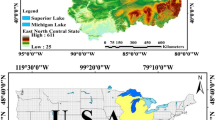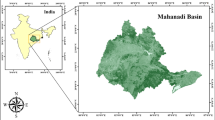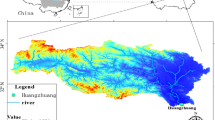Abstract
It is critically meaningful to accurately predict NDVI (Normalized Difference Vegetation Index), which helps guide regional ecological remediation and environmental managements. In this study, a combination forecasting model (CFM) was proposed to improve the performance of NDVI predictions in the Yellow River Basin (YRB) based on three individual forecasting models, i.e., the Multiple Linear Regression (MLR), Artificial Neural Network (ANN), and Support Vector Machine (SVM) models. The entropy weight method was employed to determine the weight coefficient for each individual model depending on its predictive performance. Results showed that: (1) ANN exhibits the highest fitting capability among the four forecasting models in the calibration period, whilst its generalization ability becomes weak in the validation period; MLR has a poor performance in both calibration and validation periods; the predicted results of CFM in the calibration period have the highest stability; (2) CFM generally outperforms all individual models in the validation period, and can improve the reliability and stability of predicted results through combining the strengths while reducing the weaknesses of individual models; (3) the performances of all forecasting models are better in dense vegetation areas than in sparse vegetation areas.




Similar content being viewed by others
References
Bannari A, Morin D, Bonn F et al (1995) A review of vegetation indices. Remote Sens Rev 13(1–2):95–120
Che JX (2015) Optimal sub-models selection algorithm for combination forecasting model. Neurocomputing 151:364–375
Chen ST, Yu PS, Tang YH (2010) Statistical downscaling of daily precipitation using support vector machines and multivariate analysis. J Hydrol 385:13–22
Chitsazan N, Nadiri AA, Tsai FTC (2015) Prediction and structural uncertainty analyses of artificial neural networks using hierarchical Bayesian model averaging. J Hydrol 528:52–62
Cortes C, Vapnik V (1995) Support vector networks. Mach Learn 20(3):273–297
Du Y, Cai Y, Chen M et al (2014) A novel divide-and-conquer model for CPI prediction using ARIMA, gray model and BPNN. Procedia Computer Science 31:842–851
Duan Q, Ajami N, Gao X et al (2007) Multi-model ensemble hydrologic prediction using Bayesian model averaging. Adv Water Resour 30:1371–1386
Gao XD, Zhang YX (2014) Prediction model of weld width during high-powerdisk laser welding of 304 austenitic stainless steel. Int J Precis Eng Manuf 15:399–405
Gao JB, Gunn SR, Harris CJ et al (2001) A probabilistic framework for SVM regression and error bar estimation. Mach Learn 46:71–89
Garcia-Ruiz JM (2010) The effects of land uses on soil erosion in Spain: a review. Catena 81(1):1–11
Georgakakos AP, Yao H, Georgakakos KP (2014) Ensemble streamflow prediction adjustment for upstream water use and regulation. J Hydrol 519:2952–2966
Ghose DK, Panda SS, Swain PC (2010) Prediction of water table depth in western region, Orissa using BPNN and RBFN neural networks. J Hydrol 394(3–4):296–304
Herrig IM, Böer SI, Brennholt N et al (2015) Development of multiple linear regression models as predictive tools for fecal indicator concentrations in a stretch of the lower Lahn River, Germany. Water Res 85:148–157
Huang SZ, Chang JX, Huang Q et al (2014) Monthly streamflow prediction using modified EMD-based support vector machine. J Hydrol 511:764–775
Huang SZ, Chang JX, Leng GY et al (2015) Integrated index for drought assessment based on variable fuzzy set theory: a case study in the Yellow River basin, China. J Hydrol 527:608–618
Iwasaki H (2009) NDVI prediction over Mongolian grassland using GSMaP precipitation data and JRA-25/JCDAS temperature data. J Arid Environ 73:557–562
Karamouz M, Ahmadi A, Moridi A (2009) Probabilistic reservoir operation using Bayesian stochastic model and support vector machine. Adv Water Resour 32(11):1588–1600
Lin SW, Ying KC, Chen SC et al (2008) Particle swarm optimization for parameter determination and feature selection of support vector machines. Expert Syst Appl 35(4):1817–1824
Lin GF, Chen GR, Huang PY, Chou YC (2009) Support vector machine-based models for hourly reservoir inflow forecasting during typhoon-warning periods. J Hydrol 372:17–29
Lin GF, Chou YC, Wu MC (2013) Typhoon flood forecasting using integrated two-stage support vector machine approach. J Hydrol 486:334–342
Luo L, Wood EF (2008) Use of Bayesian merging techniques in a Multimodel seasonal hydrologic ensemble prediction system for the eastern United States. J Hydrometeorol 9(5):866–884
Mohammad AG, Adam MA (2010) The impact of vegetative cover type on runoff and soil erosion under different land uses. Catena 81(2):97–103
Noori R, Yeh HD, Abbasi M et al (2015) Uncertainty analysis of support vector machine for online prediction of five-day biochemical oxygen demand. J Hydrol 527:833–843
Nunes AN, de Almeida AC, Coelho COA (2011) Impacts of land use and cover type on runoff and soil erosion in a marginal area of Portugal. Appl Geogr 31(2):687–699
Pettorelli N, Vik JO, Mysterud A et al (2005) Using the satellite-derived NDVI to assess ecological responses to environmental change. Trends Ecol Evol 20(9):503–510
Piotrowski AP, Napiorkowski MJ, Napiorkowski JJ et al (2015) Comparing various artificial neural network types for water temperature prediction in rivers. J Hydrol 529:302–315
Shiau JT, Feng S, Nadargjah S (2007) Assessment of hydrological droughts for the Yellow River, China, using copulas. Hydrol Process 21:2157–2163
Sudheer KP, Gosain AK, Ramasastri KS (2002) A data-driven algorithm for constructing artificial neural network rainfall–runoff models. Hydrol Process 16:1325–1330
Sun WY, Song XY, Mu XM et al (2015) Spatiotemporal vegetation cover variations associated with climate change and ecological restoration in the Loess Plateau. Agric For Meteorol 209-210:87–99
Vapnik V (1998) Statistical learning theory. Wiley, New York
Wang YQ, Li Y, Wang Q et al (2014) Computational identification of human long intergenic non-coding RNAs using a GA-SVM algorithm. Gene 533:94–99
Wang J, Wang KL, Zhang MY et al (2015a) Impacts of climate change and human activities on vegetation cover in hilly southern China. Ecol Eng 81:451–461
Wang S, Huang GH, Baetz BW (2015b) A polynomial chaos ensemble hydrologic prediction system for efficient parameter inference and robust uncertainty assessment. J Hydrol 530:716–733
Wang S, Huang GH, Huang W et al (2015c) A polynomial chaos ensemble hydrologic prediction system for efficient parameter inference and robust uncertainty assessment. J Hydrol 529:1129–1146
Wang S, Huang GH, Baetz BW (2016) Probabilistic inference coupled with Possibilistic reasoning for robust estimation of hydrologic parameters and piecewise characterization of interactive uncertainties. J Hydrometeorol 17(4):1243–1260
Westerlund J, Urbain JP, Bonilla J (2014) Application of air quality combination forecasting to Bogota. Atmos Environ 89:22–28
Xin Z, Yu X, Lu X (2011) Factors controlling sediment yield in China’s Loess Plateau. Earth Surf Process Land 36(6):816–826
Yoon H, Hyun Y, Lee KK (2007) Forecasting solute breakthrough curves through the unsaturated zone using artificial neural networks. J Hydrol 335:68–77
Yu ZB, Liu D, Lü HS, Fu XL et al (2012) A multi-layer soil moisture data assimilation using support vector machines and ensemble particle filter. J Hydrol 475:53–64
Yu H, Sun C, Yang W et al (2015) AL-ELM: one uncertainty-based active learning algorithm using extreme learning machine. Neurocomputing 166:140–150
Zhang ZL, Yang JG, Wang YL et al (2014) Ash content prediction of coarse coal by image analysis and GA-SVM. Powder Technol 268:429–435
Zhang Y, Gao X, Katayama S (2015) Weld appearance prediction with BP neural network improved by genetic algorithm during disk laser welding. J Manuf Syst 34:53–59
Zhu LQ, Zhu WB (2012) Research on effects of land use/cover change on soil erosion. In: Zhang CS (ed) Materials Science and Information Technology, Pts 1-8. Advanced Materials Research, pp 1038–1043
Acknowledgements
This research was supported by the National Department Public Benefit Research Foundation of Ministry of Water Resources (201501058) and the project of School of Water Resources and Hydropower of Xi’an University of Technology (2016ZZKT-15).
Author information
Authors and Affiliations
Corresponding author
Rights and permissions
About this article
Cite this article
Huang, S., Ming, B., Huang, Q. et al. A Case Study on a Combination NDVI Forecasting Model Based on the Entropy Weight Method. Water Resour Manage 31, 3667–3681 (2017). https://doi.org/10.1007/s11269-017-1692-8
Received:
Accepted:
Published:
Issue Date:
DOI: https://doi.org/10.1007/s11269-017-1692-8




